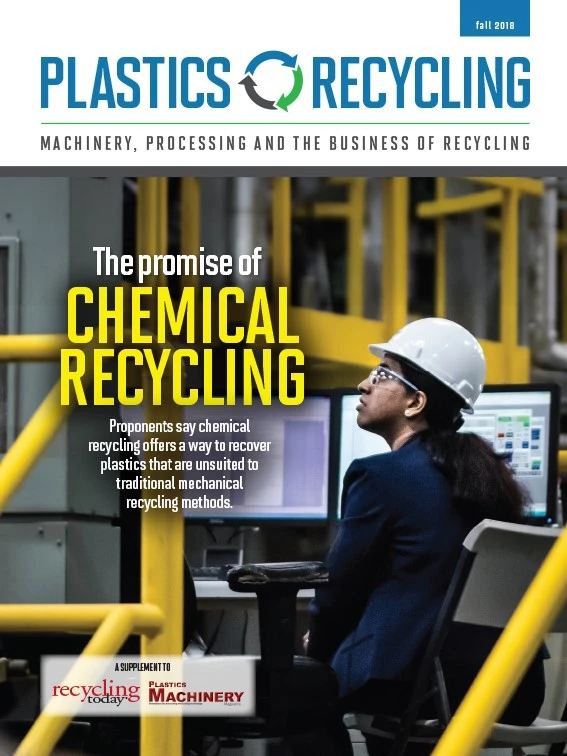
The plastics and recycling industries are well-acquainted with the mechanical recycling of postconsumer plastics. According to a timeline that appears on an American Chemistry Council (ACC) website at www.plasticsmakeitpossible.com, the first recycling facility to accept postconsumer plastics from residents began operating in Conshohocken, Pennsylvania, in 1972. In the 1980s, major U.S. cities began establishing curbside recycling programs for plastics and other postconsumer recyclables. In 1984, more than 100 million pounds of plastics were recycled in the U.S., the first time the material reached this milestone, the ACC says.
However, mechanical recycling of plastics has been under pressure as of late. Changes to China’s scrap import regulations have affected markets for some postconsumer plastics, while contamination concerns affect the yields of domestic reprocessors and increase their operating costs. Recycled plastics also can be excluded from certain applications because of their tendency to retain odors from their previous applications or because the recycled material, which can sometimes take the form of gray or black pellets, cannot be colored to brand-owner specifications.
Chemical recycling seeks to address some of these challenges by creating recycled materials of virgin-like quality, the companies behind these technologies say.
In this issue’s cover story, “The promise of chemical recycling,” Plastics Recycling looks at some of the technologies that are under development or already operating at commercial scale to chemically recycle plastics.
Of the companies mentioned, only Agilyx is operating at commercial scale. Earlier this year, the company opened what it calls the world’s first commercial closed-loop chemical recycling process for polystyrene (PS). Its plant in Tigard, Oregon, can recycle up to 10 tons per day of PS scrap to produce styrene oil that will be used by styrene manufacturers AmSty and INEOS Styrolution.
The company’s facility also can produce feedstock that can be used in ethylene and propylene production.
These achievements, enabling production of new plastic from end-of-life plastic products, represent a circular method for manufacturing feedstocks used to produce polymers, the company says.
Chemical recycling complements mechanical recycling, says Jon Timbers, senior manager of sustainability and innovation for AmSty, headquartered in The Woodlands, Texas. And, unlike mechanical recycling, which can degrade resins’ structural qualities, chemical recycling returns resins to the manufacturing stream with virgin-like qualities. “Existing recycling technologies can find it difficult to restore those properties,” Timbers said during the 2018 Re|focus Sustainability & Recycling Summit in May in Orlando, Florida.
For mixed plastics streams or plastics that are difficult to recycle via mechanical means, chemical recycling could offer the key to circularity.

Explore the November 2018 Plastics Recycling Issue
Check out more from this issue and find your next story to read.
Latest from Recycling Today
- ReMA urges open intra-North American scrap trade
- Axium awarded by regional organization
- China to introduce steel export quotas
- Thyssenkrupp idles capacity in Europe
- Phoenix Technologies closes Ohio rPET facility
- EPA selects 2 governments in Pennsylvania to receive recycling, waste grants
- NWRA Florida Chapter announces 2025 Legislative Champion Awards
- Goldman Sachs Research: Copper prices to decline in 2026





